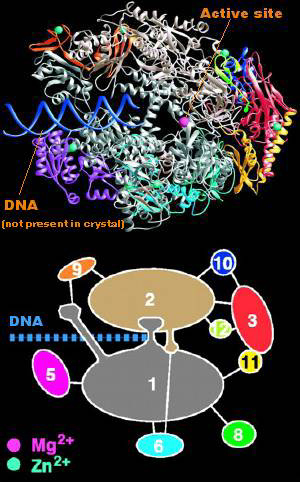 Picture of RNA Polymerase II with the subunits (RPB 1-12), Adopted
from
ALS
Science
Picture of RNA Polymerase II with the subunits (RPB 1-12), Adopted
from
ALS
Science
RNA polymerases with mutant
subunits RPB4 and RPB9 have determined that these subunits are
non-essential for transcription under normal conditions.
Interactions between the subunits, as well as, their individual study are
the current focus of research. Through cross-linking, the "use of five
species of bifunctional cross linkers of various length were inserted
between the two reactive sites and in the target amino acid residues for
conjugation" and far-Western blotting, direct interactions between the
subunits has been determined (Ishiguro 1998). Research demonstrates the
cross-linking of RPB 1 with 3,5,6,8, 11, and 12. Similarly, cross-linking
of RPB2 with 3,5,6,7,10,11, and 12 was demonstrated.
These data further supports the classification of RPB1 and RPB2 as core subunits essentially providing the structure for the polymerase development (Ishiguro 1998). The primary method of determining protein function has been to purify the associated gene, mutate, and perform experiments to make conclusions regarding viability and efficiency of binding and elongation.